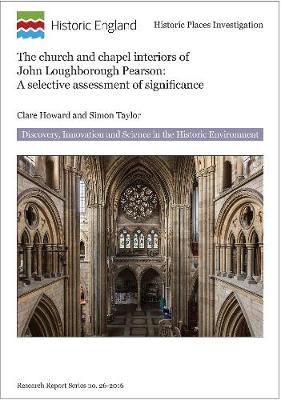Research Reports
1 total work
The Church and Chapel Interiors of John Loughborough Pearson
by Clare Howard and Simon Taylor
Published 15 September 2017
John Loughborough Pearson
(1817-97) was one of the most eminent and distinguished architects of the
Victorian Gothic Revival movement, completing designs for over 200 new churches
and church restorations in England alone over the course of his lengthy career.
Although the architecture of Pearson's churches has been studied in some
detail, relatively little research has been undertaken to understand the
significance of their interiors: the new fixtures and fittings (including
moveable and portable items) which formed part of each commission, and the
particular role of the architect in their design and execution. Without this
understanding it can be particularly difficult to address conservation issues
alongside the pressure for change and development to meet the needs of modern
congregations and other factors. This report, which forms part of a wider
national project looking at the works of prolific Victorian church architects,
presents the results of an assessment covering a selection of Pearson's church
interiors dating from the beginning of his independent career in 1843 until his
death in 1897. It is intended to assist decision-makers including Historic
England, ecclesiastical authorities and members of the public who wish to
ensure that the value of Pearson's church interiors is fully recognised and
taken into account when changes are proposed. It also serves as a pilot study
offering general guidance for the development of similar research focused on
interiors designed or commissioned by other prominent 19thcentury architects.
(1817-97) was one of the most eminent and distinguished architects of the
Victorian Gothic Revival movement, completing designs for over 200 new churches
and church restorations in England alone over the course of his lengthy career.
Although the architecture of Pearson's churches has been studied in some
detail, relatively little research has been undertaken to understand the
significance of their interiors: the new fixtures and fittings (including
moveable and portable items) which formed part of each commission, and the
particular role of the architect in their design and execution. Without this
understanding it can be particularly difficult to address conservation issues
alongside the pressure for change and development to meet the needs of modern
congregations and other factors. This report, which forms part of a wider
national project looking at the works of prolific Victorian church architects,
presents the results of an assessment covering a selection of Pearson's church
interiors dating from the beginning of his independent career in 1843 until his
death in 1897. It is intended to assist decision-makers including Historic
England, ecclesiastical authorities and members of the public who wish to
ensure that the value of Pearson's church interiors is fully recognised and
taken into account when changes are proposed. It also serves as a pilot study
offering general guidance for the development of similar research focused on
interiors designed or commissioned by other prominent 19thcentury architects.
